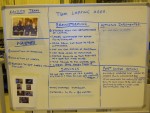How to change a habit: lean or taylorism?
A large part of the quality of what we do is down to work habits.
We can see this everyday: some people have good work habits, and work well. Others have poor work habits, and don’t work so well. Some people have good relationship habits and are a pleasure to work with, others, not so much. And, at work, some teams have good collective work habits and perform, whilst others have bad habits and struggle (and explain it’s not their fault).
But how to change a habit?
A habit is a routine of behavior repeated without much thinking about it. It’s fixed. The behaviorist approach to habits is 1) cue, 2) behavior, 3) reward – as if we were rats in a lab. It’s assumed that habits appear simply from repetition. It’s like saying that habits are habitual because they’ve become… habits.
In truth, most habits are extremely useful – they are automatic responses to a constant environment. As long as the environment doesn’t change (your morning cup for your morning cup of coffee is stored at the right place), your mind unthinkingly directs you to the right action. Habits become a problem when:
- The environment changes and you have to teach your brain a new way of reacting – it’s like the effort of changing a familiar password.
- The habit is a displacement activity, and a harmful one, such as smoking or eating junk food as a reaction to stress.
But most habits are useful, and not acquired simply as a matter of routine. Before they became routine, they were a matter of:
- Understanding the situation
- Clarifying a goal
- Experimenting with behaviors
- Settling on a behavior that appeared to have the correct results (even if we often don’t exactly understand why)
Habits need to be changed when they become harmful, mostly because the environment has changed and the behavior is no longer adapted. As we all know, habits are difficult to change because behavior seems to bypass the thinking brain, and we act before we know it.
The behaviorist approach to changing a habit is pure taylorism:
- Identify the cue that triggers the habit
- Find out what the emotional reward of the habit is: experiment until you find something else that satisfies the urge created by the cue
- Insert a new routine, and practice it for a number of consecutive days.
In other terms, recondition yourself. This might work with grabbing a cookie before a meeting, but how likely is it to work with higher thinking habit, such as engineering approach to some problems or management knee-jerk reactions?
The lean way to changing habits rests on our ability to understand that a given habit leads to outcomes that will not help us reach our stated goals. Habits change when we bring back mindfulness into habitual behavior, and when we collectively change the environment that triggers the habit.
- Measure goals and keep challenging them: are we reaching our goals? Are they still the right goals?
- Open the mind by studying mistakes: when something goes wrong, clarify what we should have done as opposed to what we did, and where does the habit lurk in there
- Change the team way of working one pattern at a time: don’t do this alone – work with your entire team to study one method and find new ideas one item at a time
- Evaluate carefully over a period of time whether the new behavior is actually performing (and whether we adhere to it)
- Move on to the next work habit that needs to be changed: what else could be improved? How can we better reach our goals?

The lean approach recognizes two key things about human beings:
- We are thinking beings – yes, we are prone to habits, but mostly, we do think about stuff and our habits reflect the fact that we didn’t need to think about it any more, so if we want to change a habit, we must get the thinking engine started again in terms of: how does this behavior help/hinder to achieve goals?
- We are social beings – it’s incredibly hard to change a habit on your own as mimetism with our immediate peer group is probably the strongest unconscious behavior driver, so if we want to change a work habit, we must do it as a team.
So that we can make a habit of changing habits. Which habit are we to change next?









